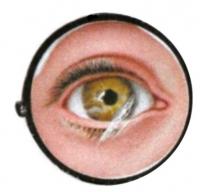
Welcome to a new week, and almost to a new month, that of October, a strange one, for as the nights get steadily darker and the mornings refuse to allow the light shine through, along comes Hallowe`en.
And this means it is almost time for the re-appearance of our yearly tribute to the spookiest of all the festivals of the annual calendar. Also, I must admit, to one of my favourites, in as much as the flickering candles, starcrossed loves, vampires, and the romantic sighing of the ghosts. I am not one for the blood and the gore.
This week I have the pleasure of announcing that all the cards ever used as our Cards of the Day are at last indexed, and ready to be used in your research. The site has moved though, and you will now find it housed under the "Collecting" tab - though the web address remains the same - https://csgb.co.uk/gallery Unfortunately, my promised plans to start straight into updating the issuers, one by one, has not yet begun, but it remains the next job on this site. Also, you might have noticed that the top of that page is slightly different and now includes a card illustration. This is something that will eventually spread to other pages too.
You will also notice we have two new pages, which are accessed through the "House of Cards" tab - one is for next year`s Convention, and one for our next postal auction. Both these are currently empty, but will be filled quite soon. At the moment we are still in the planning stage.
And so to the newsletter for this week.... which contains the start of the spooky season, a country stepping up, a twenty year long unbroken record, a dream that never quite made it, a singer and actor whose music I like very much, a man who made everyone twist in a good way, and probably the most romantic rails of all time. Lets start with :
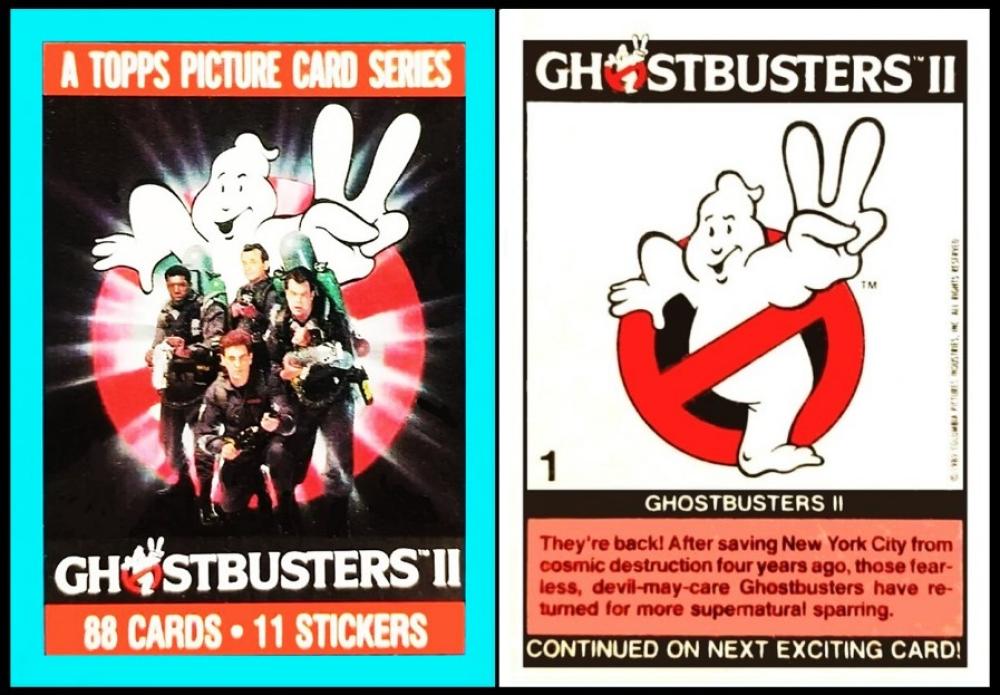
Topps [trade : bubble gum : O/S - USA] "Ghostbusters II" (1989) 1/88
It seems odd, with my mention of Hallowe`en above, that today is National Ghost Hunting Day. This day was founded by Haunted Journeys, in 2016. Now I do not seem to be able to access their website, but they are a company who runs a website which collects sightings and memorabilia of spooky events, and therefore aims to introduce the general public to take more of an awareness in the mystical side of life, in things that we can feel rather than see.
Television and film are full of ghost hunts, some more authentic than others, and some definitely focus more on the humour. The first ever film involving a ghost was made in 1896 by Georges Melies. Called "Le Manoir du Diable" (the House of the Devil), this was an eye popping spectacle involving all manner of apparitions, but not much in the way of a story.
The first written ghost story is said to be "The Castle of Otranto," by Horace Walpole, which was published in 1764 - but people who have returned from passing on appear in many myths and legends, as well as Homer`s "Odyssey", which was written around 750-650 B.C.
Our card comes from one of the most popular films in recent years, but maybe that word "recent" dates me. The original "Ghostbusters" film was released in 1984, and it was written by two of the stars, Dan Aykroyd and Harold Ramis.
The first cartophilic "Ghostbusters" item was issued in 1986, by Diamond Publishing Inc. of Illinois, and it had 180 stickers, though they were all art drawn and not live action, the reason for this being that these were based on a cartoon series and not the film. This series also provided the artwork for the 1988 series of stickers by Panini. It therefore, as far as I can find out, does not appear that the first "Ghostbusters" movie was ever recorded on cards or stickers. But maybe a reader knows of one?
This all changed with Ghostbusters II, which was copiously commemorated with cards, and stickers, and also, for the most part, used the footage from the movie. You can get complete sets by O-Pee-Chee (Canada), Topps (USA), and Regina (Australasia), though do note that all these cards are the same eighty eight pictures as each other, with very minor colour shade differences to the back.
There were also stickers, a set of eleven, which are not film footage. These are cartoons of some of the ghosts and other spirits being hunted, and they were only issued in Canada and America, not in Australasia.
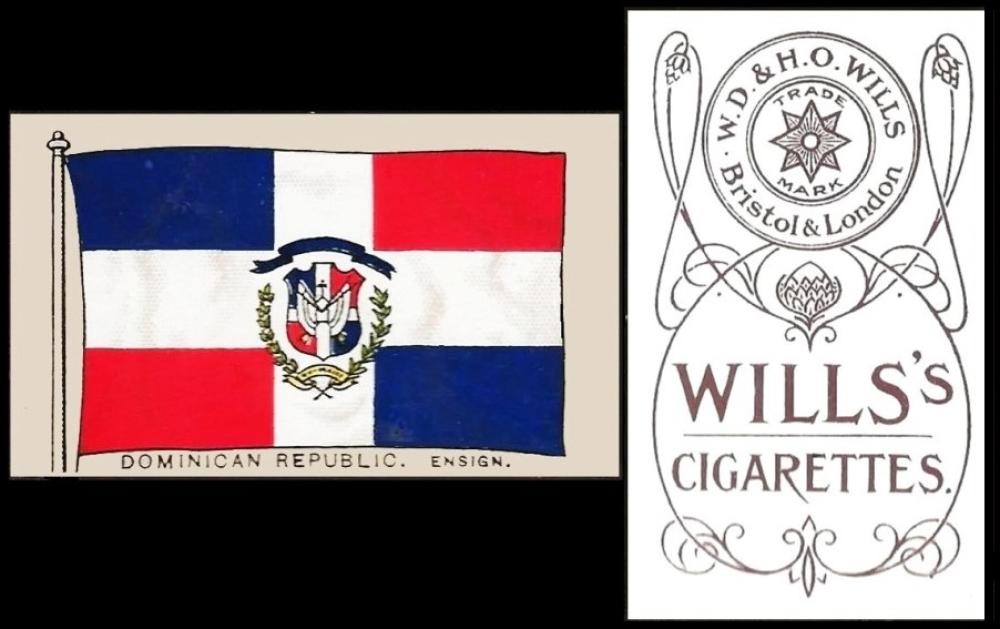
W.D. & H.O. Wills [tobacco : UK - Bristol] "Flags & Ensigns" - untitled (1903-1910) Un/126 - W675-584 : W62-414 : W/66
This is our only Centenary of the week, and it marks the date that the Dominican Republic joined the League of Nations.
The Dominican Republic came in the third group, after the original Allied founders and their invitees. This third group started in December 1920 with six countries, Albania, Austria, Bulgaria, Costa Rica, Finland, and Luxembourg, with another batch joining in September 1921 that included the Dominican Republic, along with Abyssinia, Estonia, Hungary, The Irish Free State, Latvia and Lithuania. We know that they were active members of the League and took part in many votes - also, that in December 1939, they were one of the seven countries who voted to expel Russia over their invasion of Finland.
Their own story began when the island was discovered by travellers from Central and South America, who settled there, thousands of years ago. They lived there quite happily and much evidence of their way of life remains. The island was eventually split up into five sections, each overseen by a chief. However, in 1492, a wind brought along Christopher Columbus, and he took the land for Spain, calling it allowing his brother to build a proper settlement, which he called Santo Domingo. As for the original inhabitants, they fought back but then start disappearing, some through not so friendly fire and others through disease and malnutrition. Some seem to have been forced to work for the Spanish, and it is reported that when they died they were replaced, by people from Africa.
The next change came when other explorers found the islands. These were French, and they fought the Spanish. They seem to have fought well, as in 1697 it was decided that a third of the island was to be given to the French. They called their bit Saint Dominique. However they were even more prone to the importation of slaves than the Spanish.
This arrangement, of the split island, lasted for about a hundred years, then Spain gave their bit to France, some say because of their defeat in the War of the Pyrenees, but others that the Spanish were failing to make a go of their part of the island and decided to cut their losses, thinking that the French would snap up the chance to own the whole lot. In fact it did not quite work out as planned, and the start of 1804 saw the whole island gaining their independence and being renamed as Haiti. This is when the flag on our card seems to have started to be created, or at least the horizontal stripes of blue and red which form part of the background.
Almost immediately they started to expel the French; and a short while after that, they declared that they wanted to reunite with Spain. This happened within the space of just five years.
The times which followed saw many attempts at governments, and dictators, and in the 1840s the next part of our flag was added when a group of revolutionaries put a white cross on top of the blue and red stripes. When they took control of the country they made their flag the official one, on November 6, 1844, but with a difference, they flipped the stripes at one side. The only addition to that flag is the central logo, but this is only used when the flag is being used for an official reason, not as a general country flag.
This set is first listed in our original reference book to W.D. & H.O. Wills, part III, as :
66. 126. FLAGS AND ENSIGNS (adopted title). Size 58 x 35 m/m.
Unnumbered. Fronts per Fig.43, litho-graphed in colour, grey-stone coloured backgrounds. Backs in brown, with star and circle trademark, as Fig.33a on page 86. General overseas issue between 1903-10.
There then follows a list of all the subjects.
In reference book part V there was a bit more information, namely that :
Some of the designs in this series were used in a series entitled "Flags of All Nations" issued in Australia and advertising "Yankee Doodle" and other brands of the British American Tobacco Co. (Pty.), Ltd. (An Australian subsidiary of B.A.T.).
The date of issue for our set remains a mystery, and it does not appear in the lists of printing dates which were circulated as part of the Wills "Works" Magazine. This means that the set was printed in Australia, and distributed, rather than being printed at home and exported out.
In our World Tobacco Issues Indexes the set is recorded, simply, as :
FLAGS AND ENSIGNS. (A). Sm. 58 x 35. Back in brown. Unnd. (126). See W/66
The updated version also, unusually, carries the W/66 reference, but this is due to the fact that the original five booklets were reprinted as a single volume some time after all were out of print, and this is quite easy to get hold of. In fact we still sell it in our library, reprinted again, but this time as a combined volume of even larger content, for now it contains the five Wills booklets and the British American Tobacco booklet.
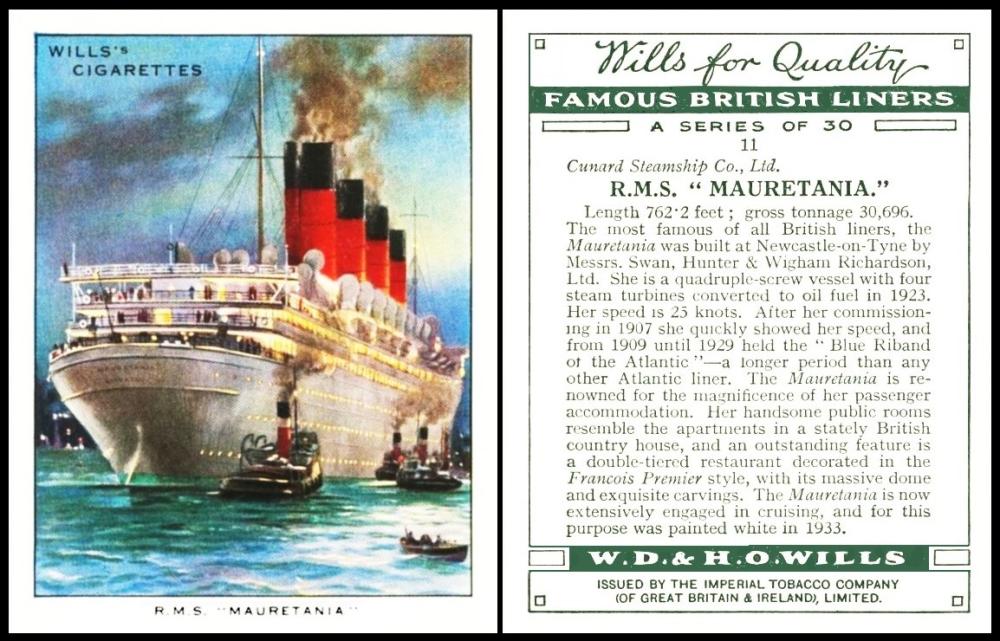
W.D. & H.O. Wills [tobacco : UK - Bristol] "Famous British Liners" (June 1934) 11/30 - W675-170.1 : W62-132.1 : W/201.1
Here we have Cunard`s R.M.S. Mauretania, in a very striking pose, and what a thrill this card must have given early collectors when it popped out of the packet.
She was primarily a liner, but today, in 1909, she won the coveted Blue Riband for the fastest Atlantic crossing.
This was just one of her many feats of endurance - starting, in the year that she was launched (1907), by taking the shortest time yet recorded to reach New York - five days, five hours, and ten minutes. However her first attempt did not go so well, due to inclement weather, so rough that her anchor broke free and she was herself damaged. On her return journey, though, the weather was better, and she broke the record for the fastest eastbound crossing of the Atlantic. Then in September 1909, she crossed the Atlantic in a westbound direction in just four days, seventeen hours, and twenty-one minutes.
Both these records were held, despite many challengers, for twenty years, only being beaten in 1929 by the German liner "Bremen".
During the First World War, still the holder of the Blue Riband, the Mauretania served her country. At first she was a hospital ship, and painted white. Then in 1916 she was converted to a troop carrier, and repainted dark grey. She ferried thousands of troops, to the Gallipoli Campaign, and back, but the disguise worked and she survived every trip.
Sadly, in 1935 she was scrapped, because it was felt that she cost too much to run and to upkeep. She was brought into dock and simply cut up.
A second Mauretania was built shortly after and launched in 1938. This also became a troop transporter in the Second World War, but returned to civilian duties afterwards. However, just like her predecessor, she was scrapped, in 1965.
There seems to be less cards of our vessel than I would have thought. I cannot even find her listed in the Trading Card Database, but there are nine cards in the New York Public Library/Mauretania - and I can also add Wills` "Merchant Ships of the World" (1924) card 16/50 and Godfrey Phillips "Ships and Their Flags" (1924) 12/25. Another one, and very highly prized, is Alexander Boguslavsky`s "Sports Records" (1925) 20/25, on which the front simply says "Steamers" but the back reads "In September, 1909, the giant Cunarder, the R.M.S. "Mauretania", made the journey from Queenstown to New York in 4 days, 10 hrs, 41 min. This is believed to be the fastest Atlantic passage ever made."
This set was first listed in our original Wills Booklet part IV, as :
FAMOUS BRITISH LINERS. Large cards, size 79 x 62 m/m. Fronts printed by letterpress in colour. Backs in grey, with descriptive text. Home issues.
201. 30. First series of 30. Issued 1934.
202. 30. Second series of 30. Issued 1935.
This is not too dissimilar in our World Tobacco Issues Indexes, where the entry reads :
FAMOUS BRITISH LINERS. Lg. Nd.
1. "1st series of 30".
2. "2nd series of 30"
I thought there would have been more information on the cards in the Wills booklets, but looking at the date of issue, just now, as I am rechecking, maybe I will be able to find the original New Issues Report in a contemporary magazine.....
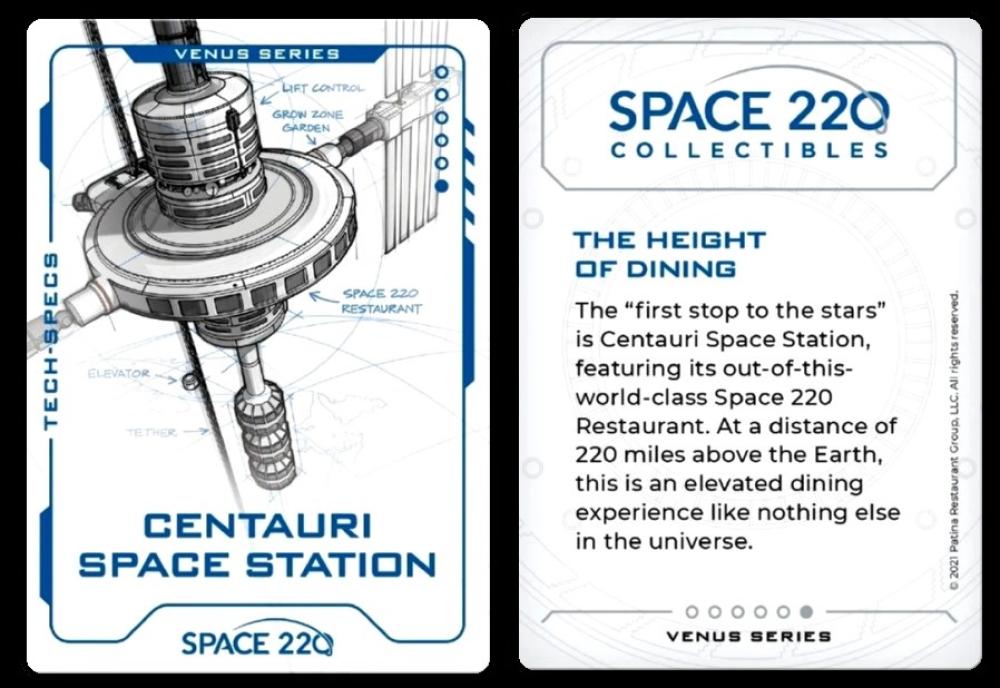
Walt Disney World [trade : meals : O/S - USA] "Space 220 Cards" - Venus Series (2021) Un/6
To an experimental community now, built as part of Walt Disney World, and opened today in 1982. This was E.P.C.O.T, or "Experimental Prototype Community of Tomorrow".
Now originally this was planned to be a community, with residential living, schools, and workplaces, over three hundred acres, which would strive to make technological advances, testing and designing new products as part of their daily lives. That was a dream of Walt Disney, though, and once he died, in 1966, it was seen as being too impractical, so though it was built, it was purely as a part of the theme park, albeit with rides and attractions that leaned towards technology.
The central feature of the park is a huge geodesic dome in silver, known as Spaceship Earth. This is actually a ride, inside, that takes just fifteen minutes and tells the story of communication and how it has shaped the future.
Another of the attractions, at least for cartophilists, can be found at the Space 220 cafe, for since 2021 they have given away limited edition packs of trading cards. At first these were only given to selected guests at random, but more recently they have been placed inside children`s meal boxes.
The most sought after are the white ones, as we show here.
The sets so far issued have been Mercury, Venus, Earth, Mars, Jupiter, Saturn, Uranus and Neptune, and each set is complete in five colour cards and one white one.
You can see all the cards at Blog.Mickey/Space220Cards, and if you are travelling there, especially with children, you may well be lucky to be given some too. Alternatively, they do turn up at online auction sites.
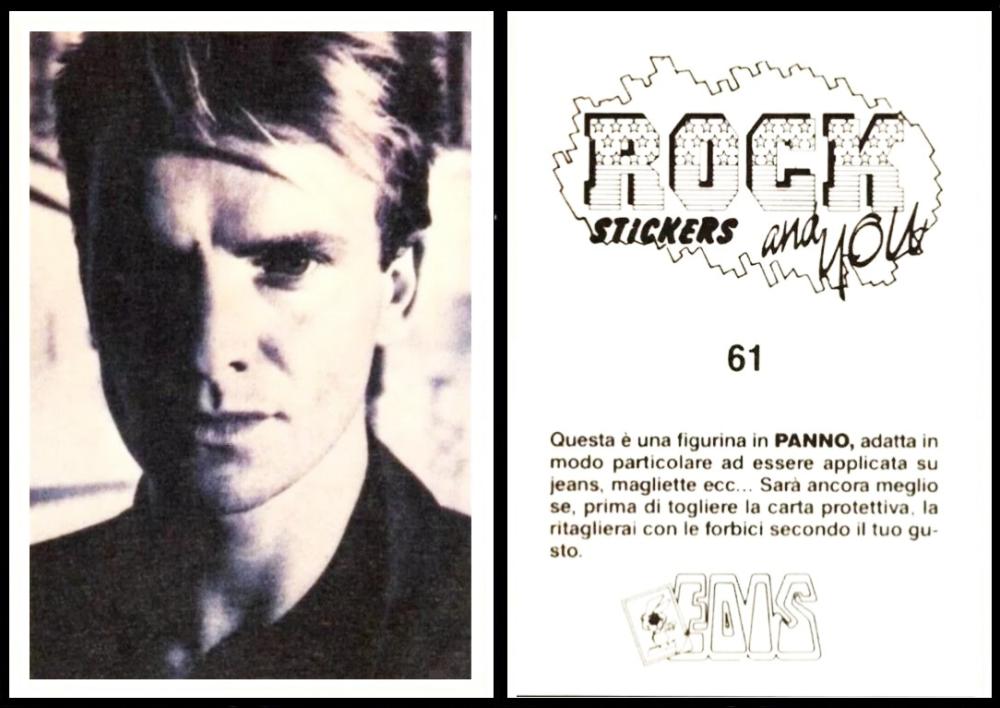
Edis [trade/commercial : stickers : O/S - Italy] "Rock and You" (1987) 61/200?
Today in 1951 saw the birth of a boy called Gordon Matthew Thomas Sumner, but you know him better as "Sting", as once the lead singer of the band called "The Police" and now as a solo singer. He is also an activist, for environmental causes.
He was twenty five, and newly relocated from his home town of Newcastle to London, when he met Stewart Copeland and formed "The Police".
The next year, in 1978, saw the first of their chart topping albums, but the original line up had already changed, as had their inspiration, for they started out being edgy and punk-y, but soon added the reggae and blues themes that saw them soar to even greater success.
In 1983 they were playing New York, the high spot of their career, but the band broke up shortly after, some, especially our man, feeling that they would never again reach those heights, so it was best to quit at the top rather than plummet to obscurity. There have been attempts to reform, but they have seldom been more than one off`s, and more is the pity.
Meanwhile, Sting is still working, composing songs for film, television, and musicals, and also acting, including in David Lynch`s "Dune" in 1984, where he played Feyd-Rautha Harkonnen - to great effect.
Card wise, a list of his twenty-nine cartophilic appearances with The Police appear at the Trading Card Database/The Police.
There is another page on the same site devoted to the 1984 Fleer set of cards which were issued with bubble gum and tied in with "Dune". The stickers for this set are listed on yet another page; again, each packet contained a stick of bubble gum, plus ten assorted cards and a sticker.
I am not sure how our set was issued, but I am intrigued by the fact that it must have been made for the British market, because the title is in English, though the rest of the text is in Italian, which is where the stickers were made. It is an intriguing set though, which has both art cards and real photos, but also includes film posters, and some subjects which do not immediately call music to mind.
I also have no idea of how many stickers there were, so if you do, please tell us.
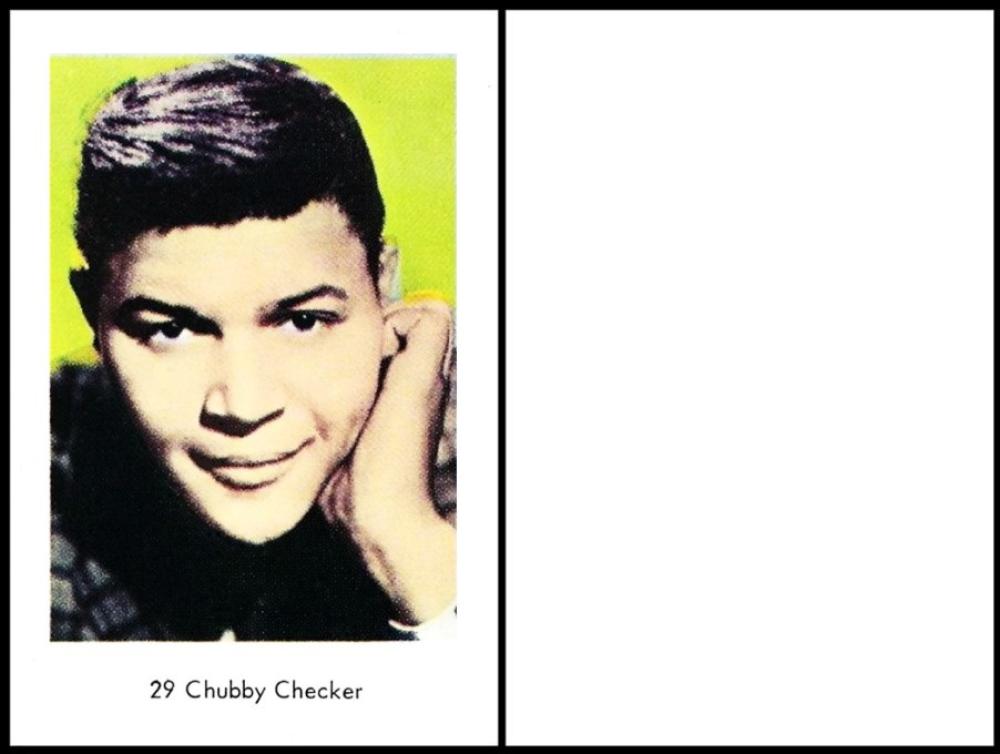
Staying with the musical "theme", today in 1941 saw the birth of Ernest Evans, in South Carolina, USA. He sang all the time, and joined various bands, as well as having quite a neat line in impersonating musical stars who were already well known. He also had a proper job though, at a produce market, and this proved to be his breakthrough, for his boss arranged for him to make a record.
As for our man`s stage name, "Chubby" Checker, it is often said to be a little tribute to "Fats" Domino. There are many people who claim that they had the idea, and it seems that we will never know for sure.
What we do know is that his first record was released in the Spring of 1959. This was a novelty song, which he sang under the guise of a school teacher, whose class included several musicians, all of whom were played by Chubby Checker. It was great fun, and though it was intended not to be released as a single, everyone that heard it loved it, and so it was.
Sadly this was just a record, not a video, so the impressions were only vocal.
In the same year, fate stepped in. There was a band called The Midnighters, and they sang a catchy little song called "The Twist". One night, at a club, Chubby Checker sang it, slightly more up tempo, and it took off, especially after he performed it live on the Ed Sullivan Show, so much so that it went to number one on the charts. He then performed it for a younger audience on American Bandstand, and once more it rocketed to number one.
This card was issued in Holland, but it is a space filler, because there is a set of cards which I would dearly like to feature, but do not own. These were issued by Wand confectionery and show Chubby Checker dancing the Twist. So if anyone has one of those cards and would like to donate a scan of front and back we would be most grateful. And I will then add the details of that set instead.
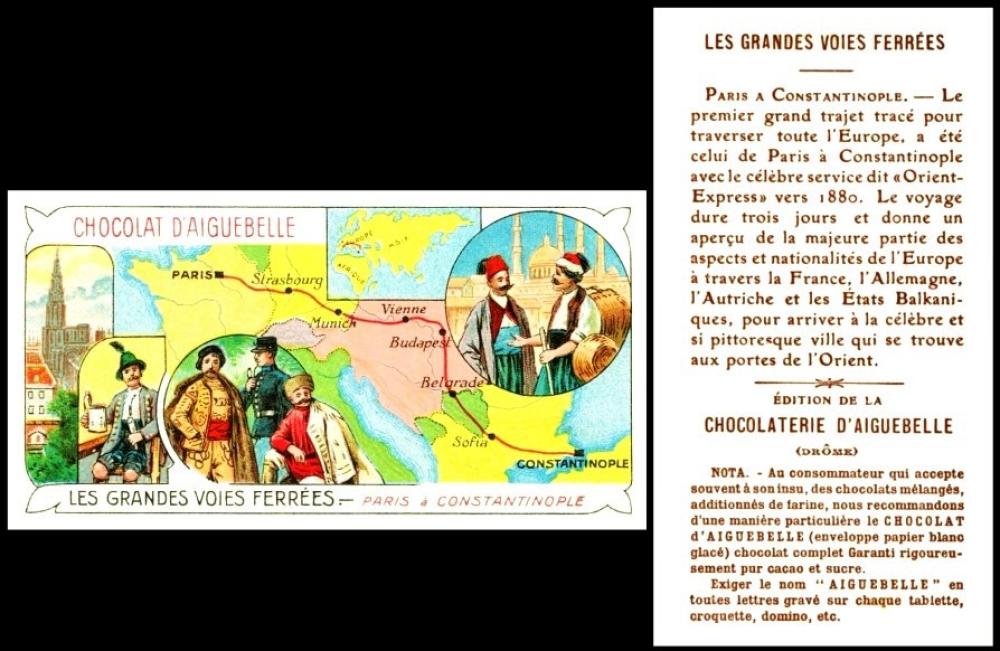
Aiguebelle [trade : chocolate : O/S - France] "Les Grandes Voies Ferrees" / "Long Journeys by Rail" (19?) Un/?
And, finally, let us go to sleep, rocked by the gentle rhythm of the railways, and the promise of waking up tomorrow in another country.
As the card above tells, we are on the Orient Express. However the text says that it started in 1880, and I have not found anything to support this. Even the so called "test train", a private trip from Paris to Vienna, organised by a banker`s son called Georges Nagelmackers, took place between the 10th and 13th of October 1882.
We also know that it was such fun that he decided to do it all again, and sell tickets. He also called this train the "Express d`Orient", referring to the fact that the train went towards the Orient at rapid speed, in other words with few stops. The first one of these trips left Paris on the 5th of June 1883, heading to Vienna in Austria, and stopping only once, in Munich in Germany.
Then, on this day in 1883, the journey was extended. These passengers went to Giurgiu, in Romania, disembarked, and took a ferry across the River Danube, after which they boarded another train to Varna, in Bulgaria. When they got there, they hopped on another ferry, and this took them all the way to the end of their journey, which was Constantinople.
This card shows the route, starting in Paris, but adding Strasbourg before Munich, next Vienna (the original terminus), then Budapest, Belgrade, Sofia and, at last, to Constantinople. I cannot really date this card from that, but imagine it to be some time in the 1920s or 30s.
I have had a look online and found eighteen more cards from this set, namely :
- Alexandria and Cairo to Khartoum
- Berlin to Naples and Palermo, Italy
- Cairo to Cape Town, South Africa
- Constantinople to Mecca, Saudi Arabia
- Kandahar to Calcutta, India
- Kharbine to Pekin, China
- London, Calais, to Brindisi, Italy, via Mt. Cenis
- New York to San Francisco, USA
- Paris to Berlin and St Petersburg, Russia
- Paris to Lisbon, Portugal
- St Petersburg to Varsovie, Milan and Cannes, France
- San Franciso to New Orleans, USA
- "Trans-Andins" - Lima to Valparaiso, South America
- "Le Trans-canadien" - Vancouver to Halifax in Canada
- "Trans-caucasian" - Batoum to Samarkand, Asia
- "Trans-Siberian" - Moscow to Vladivistock, Russia
- Tunis to Oran, Morocco
If anyone knows any others do let us know.
This week's Cards of the Day...
have been looking at how Sir Francis Drake circled the world by ship, for nearly three years, and made it home again, on September the 26th, 1580.
Saturday, 21st September 2024
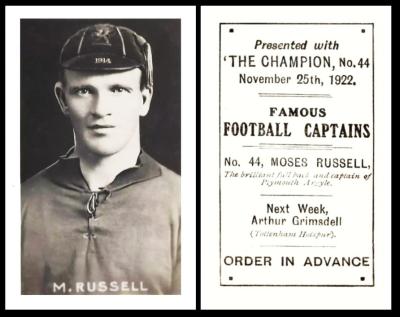
This clue referred to the team, Plymouth Argyle, for though Francis Drake was born in Tavistock, Devon, he was sent young, to a relative, a William Hawkins, who was a sea captain, based in Plymouth. There are other links between our man and Plymouth too - in 1572, it was where he was playing bowls when told of the Spanish Armada. And he became its mayor in 1581.
This is Moses Russell, described as "The brilliant full-back and captain of Plymouth Argyle".
His full name was Moses Richard Russell, and he was actually Welsh, being born in Tredegar on the 20th of May 1888, so when this card was issued he was thirty-four years. He started out as a coal miner, but was spotted by someone from the Ton Pentre team whilst having a knockabout with the other miners.
The Trading Card Database/Moses Russell has him on six cards but does not include ours. They have his "Rookie" card as Cope Bros. "Clips" branded "Noted Footballers", which started to be issued in 1910, and he is listed on that card as being with Ton Pentre.
Plymouth Argyle was his team for most of his life, starting in the 1913-14 season (though Gallaher`s "Famous Footballers" (1925) says that he "was secured by Plymouth Argyle in 1911-12), though he did start out with a couple of Welsh teams and also played for Wales as an International. He is wearing one of his caps here in this picture, and actually without it he would have been quite bald, having lost his hair through rheumatic fever as a child.
During the First World War he was in the Army Service Corps, working with the Mechanised Transport Division. Because he was an ex-miner, it is likely that this was something to do with mechanics and the repairing of faulty vehicles. He also served in the Second World War, and on his Wikipedia page his biographical section closes with "after the war, he worked at the Royal Propellant Factory at Chepstow where he died in December 1946". I have not been able to track down how this happened, though I can add that this was actually at Caerwent, not Chepstow - and that it was where the munitions for the Royal Navy were made, involving cordite, sulphuric acid, and nitroglycerine.
This card is a bit confusing, too, because it is titled "Famous Football Captains", but it is actually part of a larger set which was called "Sportsmen" by early researchers. We featured a card from "Sporting Champions" in our newsletter for the 29th of September 2023, as the card for Sunday the 1st of October - and will try and get one of each of the others shown too as we progress.
The group is listed in our original British Trade Index part I as :
SPORTSMEN (A). Sm. 68-70 x 43-45. Black photos. Nd. Dated 22-1-22 to 28-4-23. (C). ... AMC-16.
1. "Sporting Champions" - Nd. 1/29 and 42
2. "Famous Football Captains" - Nd. 30/41 and 43/57
3. "Famous Footballers" - Nd. 58 and 60/62
4. "Billy Matthews" (Boxer - No.59) and "Famous British Record Holders" - Nd. 63/66
This information is added to in part III of the original British Trade Index, by a discovery, that being that
Two different subjects were issued at Nos. 3 to 5, clearly to cater for readers in Scotland and England, as follows -
No.3 ..... J. Rutherford (Arsenal/England) - J. Gilchrist (Celtic)
No.4 ..... Horace Barnes (Manchester City) - Alex Troup (Dundee)
No.5 ..... Jessie Pennington (West Bromwich Albion) - N. Harper (Hibernian)
As far as "The Champion", it was a newbie, being first published on the 28th January 1922. However that does not compute with the date of our first card given in the above listing, which says "22-1-22".
I have now had a chat to a collector, and he says that card number one was actually Georges Carpentier (Boxer). The reverse of this card says "Presented with "The Champion" No.1 Jan 28th 1922 - Sporting Champions - No.1. Georges Carpentier Lt H.W. Champion of the World. Next Week : Jimmy Wilde - Order In Advance".
Sunday, 22nd September 2024
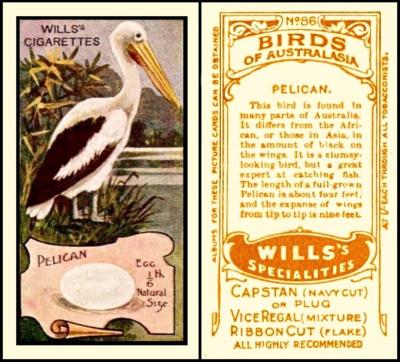
This fine feathered bird related to the galleon on which Francis Drake sailed around the world.
Now you may be puzzled at this, because we know it today as the "Golden Hind" - however when she sailed out of the harbour on the maiden leg of its voyage, she was called "The Pelican". She was only renamed about half way round in honour of his patron, and sponsor, a man called Sir Christopher Hatton, whose crest was a female deer, or a hind, in gold.
This set was first listed in our original W.D. & H.O. Wills reference book part III, as :
50. 100. BIRDS OF AUSTRALASIA. Fronts printed by letterpress in colour; backs with descriptive text. Australian Issues :-
Backs in Green - issued about 1912:-
A. With "Capstan" advertisement (a) dull (b) glazed backs.
B. With "Vice Regal" advertisement (a) dull (b) glazed backs.\
C. With "Havelock" advertisement.
In series A-C there is much variation in size, due to uneven cutting, and in the type used for numerals - the same number being found in different stylesBacks in Chrome-yellow- issued about 1915 :-
D. With "Havelock" advertisement
E. With "Wills`s Specialities" advertisementThroughout the series A-E there is much colour variation, both in backs and fronts. In the case of fronts, many cards are found with one or more of the colour processes missed.; back colouring varies from light to dark with a series of intermediates
There follows a comparison of titles list, to be scanned some time. After that it continues ;
There are various differences as between fronts and backs, and between the subject titles in A-C and D-E. Card No.26 is incorrectly spelt "Tue" - the bird`s name is "Tui" ; no corrected card is known. A series similar to D-E was also issued in Australia by "Village Maid Confectionery"
Interestingly, though this version is dated 1915 it does not appear in the list of overseas sets that was printed in the Wills` Works Magazine. What this means is that these cards were printed locally in Australia, and not in the British Isles.
The Village Maid link is interesting as well, and needs further investigation. I have seen a few cards and the fronts are the same, but the backs are different. It also turns out that Village Maid also issued a set called "Sports of the World" and the fronts of the cards I have looked at from the Wills version of that are also identical too.
Now by the time this set appears in our original World Tobacco Issues Index, it is recorded as :
BIRDS OF AUSTRALASIA. Sm. Nd. (100). See W/50 ... W62-218
A. Back in green. Brand issues:-
(a) "Capstan" back.
(b) "Havelock" back
(c) "Vice Regal" backB. Back in chrome-yellow. Subjects differ from A. at 18 numbers.
(a) "Havelock" back
(b) "Wills`s Specialities" back
It is identical to this, except less spaced out, in our updated World Tobacco Issues Index; however the card reference code has changed.
Monday, 23rd September 2024
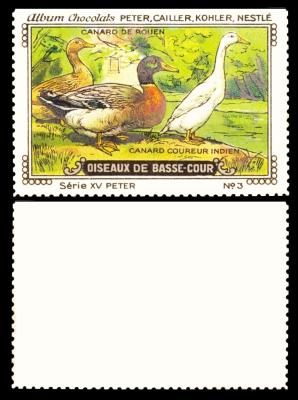
The final clue is a bit of artistic license on my part, but this is a duck, or two, and the male duck is called a Drake. Curiously the word comes all the way from Old English, where a male duck, or what was known then as a "duck king", was called an Andraca. As for what a female duck was called, sadly, it is not a "duck queen", it is just a hen.
Now the Rouen Duck may just look like a normal duck, but it is much larger, up to about six kilos. It comes from the Rouen area of France and it was prized for the fact that its largeness meant more meat. This is still the case in the more rural areas, but they also have a new lease of life as it were on the exhibition table with shows and competitions for the heaviest and most beautiful.
As far as Indian Runners, they are so named because they stand up on their hind legs and run about, in a most curious way. However, if we are being totally correct, they ought to have been named Indonesian Runners for they are found in Java and Bali.
This card is unusual because at the bottom it says "Serie XV Peter", and the "Peter" is not usually there. I did think that perhaps Peter issued the set first before the companies combined and so maintained the copyright, but then I found the same set without "Peter" at the bottom. And you can also find it as "Serie 49" - and as "Serie XXXXIX", all of which are by all of the names without the "Peter" at the bottom
Anyway this is set of twelve cards, and very attractive they are too. As far as the birds which form the set, they are :
- Pigeon Romain / Pigeon Carrier - (Roman Pigeon / Carrier Pigeon)
- Pigeon Paon / Pigeon Capucin / Pigeon Boulant - (Fantail / Jacobin / Pouter or Cropper)
- Canard De Rouen / Canard Coureur Indien - (Rouen Duck / Indian Runner Duck)
- Oie de Toulouse - (Toulouse Goose)
- Canard Muet ou de Barbarie - (Muscovy Duck)
- Faisan Dore - (Golden Pheasant)
- Faisan Ordinaire - (Common Pheasant)
- La Pintade - (Guinea Fowl)
- Le Dindon Noir - (Black Turkey)
- Le Paon - (The Pheasant)
- Paon Blanc - (White Pheasant)
- Cygne Blanc - (White Swan)
Tuesday, 24th September 2024
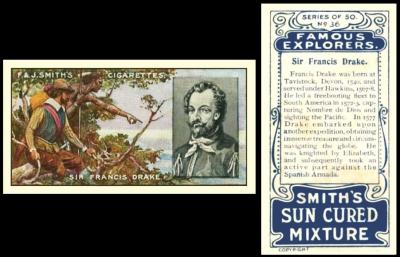
The reverse of this card provides us with the fact that "Francis Drake was born at Tavistock, Devon, 1540."
In fact we do not know when he was born, only that it was at his father`s farm, and that he was one of twelve children. His birth year is only guessed at from words written about him, whilst he was alive, and there are many different years that these relate to. The date of 1540, which is given here, and often elsewhere, is entirely attributed to a miniature painting by the renowned Nicholas Hilliard, at which time our man said he was forty-two years of age, but he may well have been cagey about his age, wanting to appear younger, or older.
A quick look at other cigarette cards of Francis Drake show this confusion. Taddy`s "Autographs" (1912), No.12, gives 1539. Brooke Bond`s "Adventurers and Explorers", No.13, gives us 1453. And both W.D. & H.O. Wills` "Builders of Empire" (1898), No.3, (which is usually credited as his "Rookie" card) and Ogdens/Players "Leaders of Men" (1924 and 1925), No.16, have 1545.
Now there is another discrepancy, because though Brooke Bond`s "Discovering Our Coasts" (1989) No.28, states "Born in Devon of poor parents", and many other sources say that he was but a simple farmer`s son, this seems to have been no ordinary farmer, for he had some notable connections - minor nobility, and sea captain William Hawkins, son of John Hawkins, into whose care Francis Drake was placed whilst still quite young.
There is often spoken of a link between William Hawkins and Francis Drake`s mother, in that she was his daughter, but there is no concrete proof of this. Indeed, when William Hawkins died it is only recorded that he left two sons. Some say that this omission simply reflects the lack of importance of the female sex in those days, whilst others believe this daughter was not his wife`s. Now if Francis Drake was blood, through whichever of these paths, then it would explain William Hawkins` willingness to take him in - though his actual wife may have not been quite so understanding of the second.
In addition, when our man was nine years old, his father moved the whole family to Kent, and became a vicar, which points to him being rather more learned than a simple farmer - especially as just before that, he was also appointed Minister to the King`s Navy.
As this is the first appearance of this set as a Card of the Day, it seems fitting to make this its home page, to where all the other ten back versions will eventually link back.
The entry in our original World Tobacco Issues Index reads :
FAMOUS EXPLORERS. Sm. Nd. (50). Vari-backed, 11 wordings - see C.W. page 268 or N. & N. Vol. 8, page 89 ... S84-7
These two abbreviations lead to magazines, "C.W." being "Cartophilic World", which was our official magazine, and "N. & N." being "Notes and News", which was the name of the magazine belonging to the Cameric Cigarette Card Club. In 1965 both these card collecting communities merged, and it was decided to immortalise both magazines into one, by calling the next edition "Cartophilic Notes and News". Now I only have a few editions of the Cameric Notes and News, but I do have a complete run of "Cartophilic World"s, so I will fetch that edition in a minute.
These magazines were true ephemera, designed to be read but not entirely to be kept forever. They also suffered much from the rusting of the staples. So when the World Tobacco Issues Index was updated, for the Millennium, it was thought to be unlikely that too many collectors would have access to those early magazines. And so this listing reads simply :
FAMOUS EXPLORERS. Sm. Nd. (50). Vari-backed, 11 wordings. ... S548-180
After writing this I got my "Cartophilic World"s and looked. Page 285 is in Volume 3, No.34, dated December 1945, and it is part of a series by Charles Lane Bagnall, which reads :
Smith`s Issues - By C.L.B. (continued from page 264).
FAMOUS EXPLORERS
Series of 50. Issue date approx. October, 1911.Advertisements on backs.
- Albion Gold Flake Cigarettes - see Newsletter for 11 January, 2025 (Friday 17th)
- Albion Gold Flake Cigarettes
- Albion Gold Flake Cigarettes
- Albion Gold Flake Cigarettes
- Albion Gold Flake Cigarettes
- Albion Gold Flake Cigarettes
- Albion Gold Flake Cigarettes
- Albion Gold Flake Cigarettes
- Albion Gold Flake Cigarettes
- Albion Gold Flake Cigarettes
- Glasgow Mixture Cigarettes
- Glasgow Mixture Cigarettes
- Glasgow Mixture Cigarettes
- Glasgow Mixture Cigarettes
- Glasgow Mixture Cigarettes
- Pinewood Cigarettes
- Pinewood Cigarettes
- Pinewood Cigarettes
- Pinewood Cigarettes
- Pinewood Cigarettes
- Pinewood Cigarettes
- Pinewood Cigarettes
- Kashan Cigarettes
- Kashan Cigarettes
- Kashan Cigarettes
- Studio Cigarettes
- Studio Cigarettes
- Studio Cigarettes
- Studio Cigarettes
- Studio Cigarettes
- Studio Cigarettes
- Studio Cigarettes
- Studio Cigarettes
- Studio Cigarettes
- Studio Cigarettes
- Sun Cured Mixture
- Sun Cured Mixture
- Ancestral Mixture
- Luxury Mixture
- Luxury Mixture
- Cut Golden Bar "Twilight"
- Cut Golden Bar "Twilight"
- Orchestral Cigarettes
- Orchestral Cigarettes
- Orchestral Cigarettes
- Glasgow Mixture. Mild, etc
- Glasgow Mixture. Mild, etc
- Glasgow Mixture. Mild, etc
- Glasgow Mixture. Mild, etc
- Glasgow Mixture. Mild, etc
A cursory look through the internet seems to support this list, and point to the fact that this set had one back per card, as listed above. There is an error, for cards 43-45, which ought to read "Orchestra" not Orchestral.
The end of the article says "Will any reader with variations of the above please make a point of reporting them, as the information now published is to form the basis of a reference book." Now this was written in December 1945, and there was, indeed, work done on this book. In fact it was even mentioned at the back of the Lambert & Butler Reference Book, RB.9, which was published in 1948, as part of a "Suggested grouping to complete Part 1 of Programme - British Issuers", section 8 of which reads "Mitchell, Smith". And the reason for teaming the two was that in 1927 the two Glaswegian companies of F. & J. Smith and Stephen Mitchell & Son were combined. Sadly, this book never came to fruition.
Wednesday, 25th September 2024
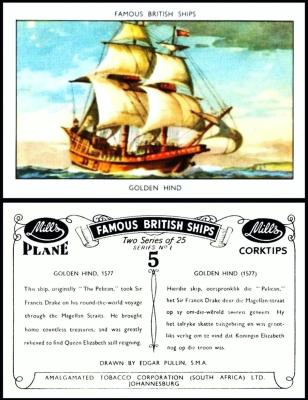
Here we have "The Golden Hind", and we used this card because the text tells us that "This ship, originally "The Pelican", took Sir Francis Drake on his round-the-world voyage through the Magellan Strait."
This strait was indeed named after Ferdinand Magellan, often said to have been the first man to circumnavigate the globe, whilst looking for the East Indies - though that is not strictly true, as he died during the voyage, and the fleet was brought home under the command of another man, Juan Sebastian Elcano. That technically means that our man, Francis Drake, was indeed the first to complete the circling of the earth in its entirety.
There is a slight inaccuracy in the text of our card though, and we will find out about that with tomorrow`s card.
As for our issuer, well that is also a curious tale. It starts out with Bocnal Tobacco Co, of Bonhill Street in the East End of London - who you can read about with our Card of the Day for the 24th of April, 2024. They were founded in 1934, and only issued two sets in 1938.
Then they became our company, "The Amalgamated Tobacco Corporation, Luton" - who are not even listed in our original Directory of British Issues, RB.7, published in 1946 - with good reason, as it turns out, for in our original World Tobacco Issues Index, published ten years later, we find :
Amalgamated Tobacco Corporation, Ltd.
Associated with Philip Allman, 1954. Trading 1956. Includes brand issue inscribed "Mills" and "Yank" Cigarettes.
1. 1948 - 1949 SERIES. Inscribed "Amalgamated Tobacco Corporation (South Africa) Ltd., Johannesburg." . Series prepared 1948-49 : Set A46-1 was not used in South Africa, because of Government restrictions, and the entire stock was transferred to the U.K. and issued in 1952. Backs in English and Afrikaans.
- FAMOUS BRITISH SHIPS. Md. 75 x 48. Nd . .... A46-1
1. "Series No. 1". (25)
2. "Series No. 2". (25)- HISTORY OF AVIATION". Md. 75 x 48. Nd. (50) ....A46-2
2. ISSUES 1953-54. Inscribed "Amalgamated Tobacco Corporation Ltd., Luton, England." Issued in UK
- KINGS OF ENGLAND. Sm. 67 x 36. Nd. (25) ... A46-6
- PROPELLED WEAPONS. Sm. 67 x 36. Nd. (25) A46-7
3. MISCELLANEOUS ISSUES
- VIC TOWEEL POSTCARD (A), Ex. Lg. 140 x 90. Autographed portrait presented with two free cigarettes at Toweel`s fight with Boland in Johannesburg, 1951. Single card brand issue, inscribed "Mills" and "Yank" Cigarettes.
Two things need a little exploration from above. The first is that the "Mills" brand came from, and was also used by Bocnal. The second thing is that I have seen a packet of "Yanks" (sic) Cigarettes, and it is actually spelt "Yanx", but I have not seen the Vic Toweel card to find out if that is spelt that way on there too and there was, perhaps, an error in translation between the sender of this information and whomsoever tapped it in to the World Tobacco Issues Index. I have found out that the fight took place on the 2nd of September 1951, at which time Mr. Toweel was the World Bantamweight champion, but that it was not a title fight - he beat Bobby Boland, of Scotland, knocking him out in the first of ten rounds.
This is where the Amalgamated Tobacco Corporation story ends in our original World Tobacco Issues Index - but the story continues still further with our updated volume - though for that you will have to hang on a bit whilst I sort out the earliest of their sets and make it the home page for the next part of the story. This will involve looking in our magazines and seeing which set was issued first out of all the ones they issued in 1957.
Thursday, 26th September 2024
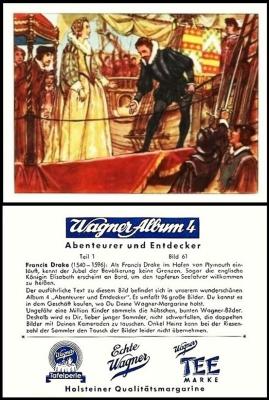
Now yesterday we said there was a slight error on the card, and that was the fact that it said "This ship, originally "The Pelican", took Sir Francis Drake on his round-the-world voyage through the Magellan Strait."
This is because Francis Drake was not Sir Francis Drake until he returned back to England. This is often said to have been done by Queen Elizabeth I, as is shown here, and she was there, but the actual touching of the sword was instead performed by a Monsieur de Marchaumont, the French Ambassador, who had come to England in order to matchmake between Queen Elizabeth I and the brother of the King of France, hence joining the two countries together.
The ceremony was performed on the Golden Hind though, which was moored in Deptford. It took place on the fourth of April, 1581.
This card is from a much later set by Echte Wagner, by which I mean much later than the others we have shown on this site, not much later than 1581. The reverse advertises Wagner "Tafelperle", "Tee Marke" and "Holsteiner Qualitatsmargarine". I have no idea what "Tafelperle" means.
The entire set covers adventurers and explorers, and there are several cards of Sir Francis Drake. They all fitted in a very handsome hard backed album, and once filled it looks just like a printed book, it is only if you find one with some missing that the secret is revealed.
Friday, 27th September 2024
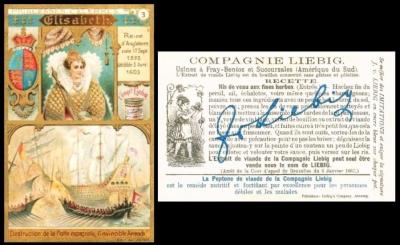
We close the week with Queen Elizabeth I. She was keen to join her rivals, Spain and Portugal, in traversing the globe in search of new lands and especially treasure, or, sadly, slaves. It is not known how Francis Drake was brought to her attention, we do know that he was already highly regarded as a seafarer and also a pirate, two things that made a fairly interesting combination, for it showed that he was skilful and also could be swayed for a price, as well as being able to keep some of his discoveries out of the public eye. So he was charged with chasing and bringing to heel any Spanish galleons that he came across relieving them of their treasure, and sharing it with the Queen - and at times when he found no ships at sea he was given command to invade harbours and ports.
The Spanish put a price on his head, of twenty thousand ducats. Interestingly, they called him "El Draque", which translated to the dragon, for his ships breathed flames of gun fire). And with these exploits on mind, perhaps, we could be more correct in thinking that the Spanish Armada was actually a reprisal against these unwarranted actions. Anyway at the bottom of this card you can see a tableau of that very Armada, which took place in 1588.
Queen Elizabeth I seems to have been a bit of a double agent in all this. Secretly she was excited by the thought of riches and treasure, but could not openly praise Drake for his acts of piracy. Then there is the curious tale of one of the men on board his round the world voyage who was executed by beheading after it was thought that he was a spy. Today we know that he was indeed a spy, but one employed by the Queen in order that Francis Drake not keep the best treasures for himself.
In 1596, his hunting of Spanish ships still ongoing, he sailed down to Puerto Rico. There is also the theory this this was to hunt for gold. The Spanish were getting cannier though and it was almost defeat. Weakened, he then succumbed to fever, and dysentery, and on January the 28th, he died, on board his ship.he had requested that his body was dressed in full armour, and buried at sea, near Panama, in a leaden coffin. This was duly done. But though there have been many attempts to locate his coffin in the years thereafter, it has never yet been found.
This set of cards was issued in five languages, Belgian (as "Princesses Célèbres"), Dutch (as "Beroemde Vorstinnen"), French (as "Princesses Célèbres"), German (as "Beruhmte Furstinnen") and Italian (as "Principesse Celebri"). Our card is in French but was printed in Antwerp. Maybe they all were?
The princesses, one per card, are :
- Semiramis
- Cleopatre
- Elisabeth
- Marie Stuart
- Catherine II
- Marie Therese
And so, dear readers, time to halt the presses for a while, and draw a close to this edition, albeit a temporary one, for once the details have been added to the cards in the Card of the Day Index, the intention remains to add in all the other cards that form part of these newsletters, plus the details of those too which were missed the first time round, for whatever reason.
Thanks for coming along and reading. I hope you were entertained, and that it made you, perhaps, add a new set to your knowledge and your wants list. That is the best thing about collecting, and also about knowledge - that it not grow stale, but that it is always added to, and that you are always finding something new to chase after and maybe, one day, catch.
See you all next week......
